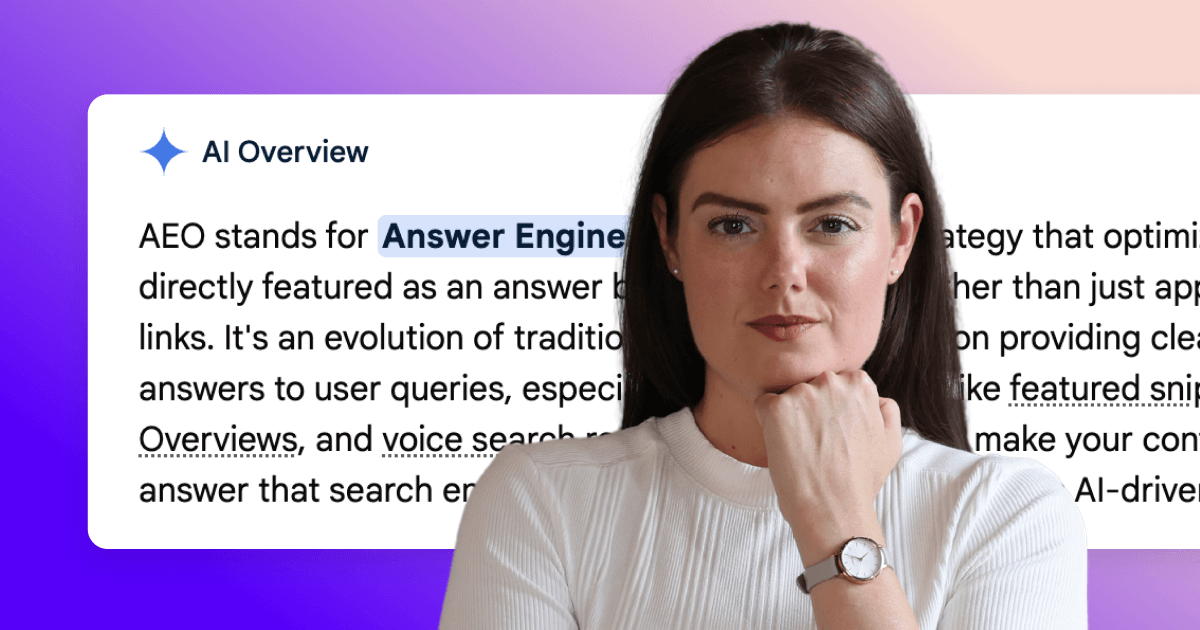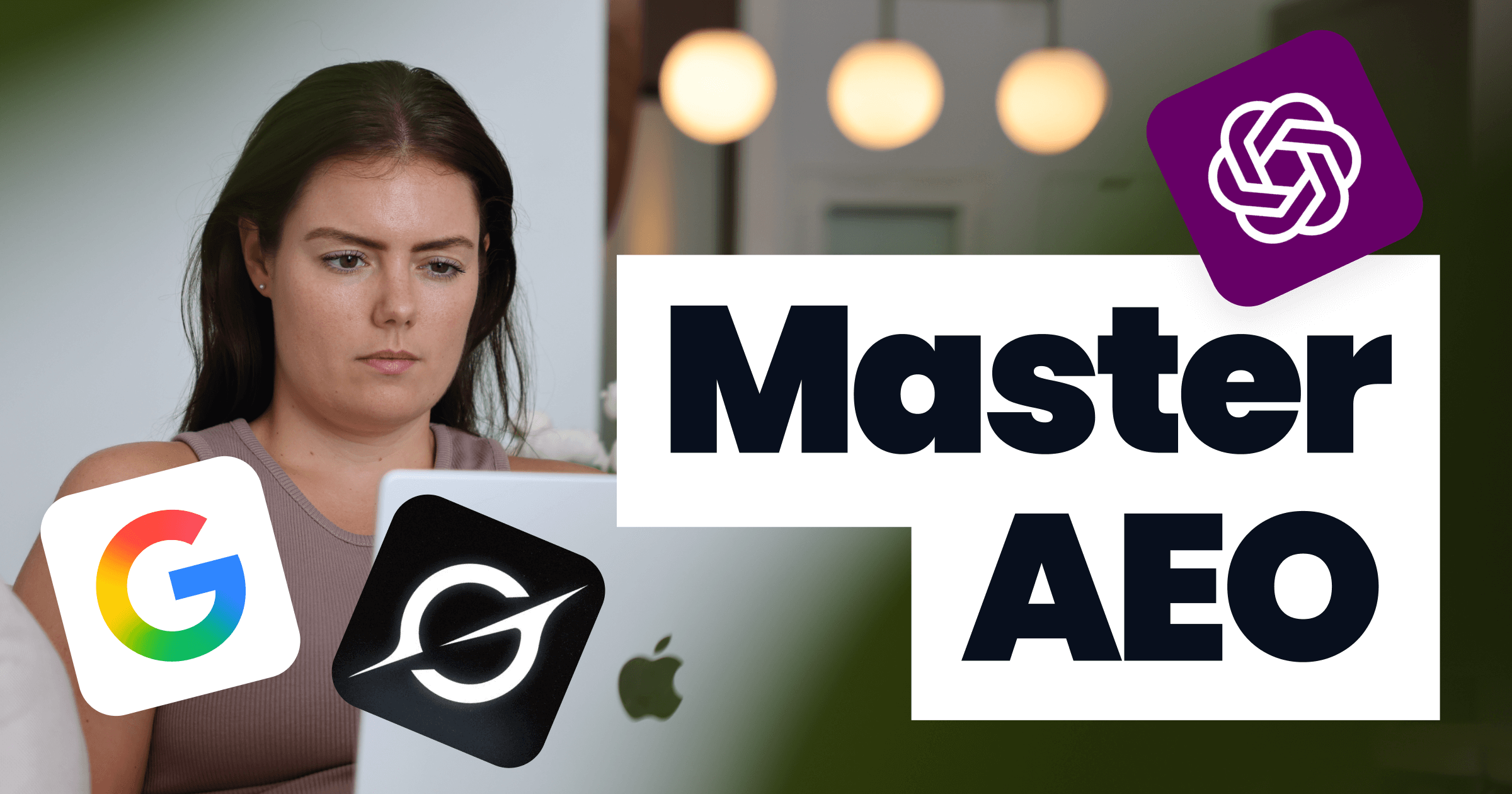
Search is changing.
Instead of typing keywords and scrolling through long lists of links, users increasingly ask conversational questions to AI‑powered answer engines.
Examples include Google’s AI Overviews, Bing Copilot, ChatGPT, Grok and voice assistants like Siri and Alexa. These tools synthesize information from multiple sources and display or speak a concise answer, often without requiring the user to click anything.
According to the marketing platform Surfer, answer engine optimization involves creating content that provides direct answers so AI platforms can cite it, rather than just ranking pages. In other words, AEO is about owning the answer, not just ranking for a keyword.
Because people increasingly rely on concise answers, structuring your content for answer engines is becoming essential.
The rise of generative AI and AI search means that information discovery is moving from browsing lists of links to receiving synthesized answers.
Predictions indicate that 2026 will be the year AI fully breaks from traditional search paradigms, making it crucial to prepare now. To stay ahead, you need to understand how answer engines operate and how to adapt your content.
This article explores what AEO means, why it matters in 2025 and 2026, how it differs from traditional SEO, and how to optimize your content to surface in AI‑generated responses. By the end, you’ll know how to show up in AI search and encourage large language models to cite your work.
What is Answer Engine Optimization?
Answer Engine Optimization (AEO) - sometimes called AI Search Optimization, AI Discovery or AI Visibility - refers to the process of shaping and structuring your content so that AI‑powered answer engines such as Google’s AI Overviews, ChatGPT, Perplexity and Bing Copilot can find it and cite it as the answer to users’ questions.
If you’re wondering what is AEO?, think of it as designing your site to be the source of truth for AI 😇
In practice, AEO requires you to think like a machine: present information clearly, answer specific questions directly and ensure your page can be read by algorithms.
AEO aims to get your webpage mentioned in AI‑generated answers across multiple AI platforms by tailoring your content to deliver direct answers.
Unlike traditional search engine optimization, which primarily seeks to move a web page up the search results, AEO focuses on making your content machine readable, authoritative and structured so AI systems can extract it and present it as the best answer.
Writesonic explains that AEO’s goal is to become part of the answer itself, citing your content inside AI responses instead of simply competing for clicks.
AEO vs SEO: Key Differences
When comparing AEO vs SEO, remember that both strategies share the goal of increasing visibility, yet they diverge in several key areas:
Output format
Traditional SEO: Ranks pages in search results and drives clicks to your website.
Answer Engine Optimization (AEO): Appears in AI‑generated answers, featured snippets and voice assistant responses.
User intent
Traditional SEO: Targets broad or navigational queries (e.g., “best running shoes”).
Answer Engine Optimization (AEO): Targets longer, conversational queries that ask for specific answers (e.g., “Which running shoes prevent knee pain?”).
Measurement
Traditional SEO: Tracks rank positions, organic traffic and clicks.
Answer Engine Optimization (AEO): Tracks citation frequency in AI answers, visibility in featured snippets/voice responses and AI‑driven engagement.
Content structure
Traditional SEO: Optimizes on‑page elements (titles, meta tags, internal links) to satisfy search algorithms.
Answer Engine Optimization (AEO): Structures content with clear question–answer pairs, conversational language and schema markup so AI engines can parse and cite easily.
Traditional SEO will not disappear; it complements AEO.
SEO and AEO work together; SEO ensures you rank on SERPs, while AEO ensures your content gets cited inside AI answers. By combining both strategies, brands can capture visibility both in classic search results and AI‑powered answers.
Why AEO Matters Now & in the Near Future
Several trends make AEO essential for marketers and content creators today and underscore its importance heading into 2026:
- Rising adoption of AI‑powered search – Surfer reports that around 25 % of new Surfer customers now originate from AI assistants. AI‑generated search tools are not only delivering traffic; they convert better - Ahrefs observed a 23× higher conversion rate from AI‑search visitors compared with traditional organic search.
- Zero‑click searches and shrinking organic clicks – According to Surfer’s analysis of SparkToro data, searches ending without link clicks rose by around 3 % between March 2024 and March 2025, while organic link clicks decreased. When AI overviews answer user queries directly, fewer people click through, so being part of the answer becomes critical.
- Explosion of voice and AI assistants – notes that over 150 million U.S. users are expected to use voice assistant devices in 2025. Voice queries often return a single spoken answer, making it essential for your content to be that answer.
- AI overviews on mainstream search – Google’s AI Overviews now appear on nearly one in five searches, and clicks drop by almost 50 % when they do. If your content isn’t structured for AEO, competitors that are optimizing for these overviews may capture your traffic.
- Increasing importance of generative search – Search Engine Land predicts that AI assistants and large language models will handle about 25 % of global search queries by 2026. That represents a massive shift in search volume toward AI platforms that synthesize answers rather than listing links.
- Higher conversion rates from AI search – Early data suggests that traffic originating from AI search can convert three to eight times better than traffic from traditional search. Optimizing for AI answers therefore not only maintains visibility but can significantly improve return on investment.
Combined, these trends indicate that AEO is no longer optional. Brands that embrace answer‑first optimization now can capture high‑intent visitors before competitors and maintain visibility as AI continues to transform search.
How AI Answer Engines Actually Work 🤖
Answer engines rely on advanced natural language processing and retrieval‑augmented generation techniques. Surfer explains that AI search engines use retrieval‑augmented generation (RAG) to combine retrieval of information with generative models. When a user asks a question, the system:
- Interprets intent and context – AI models use natural language processing to understand the user’s query and identify what information is needed.
- Retrieves authoritative sources – The engine searches its training data and the live web to find reputable sources. Website authority plays a major role; AI platforms prioritize domains deemed trustworthy.
- Generates a concise answer – The model synthesizes the retrieved information into a coherent response, often citing the underlying sources for transparency.
- Presents the answer across interfaces – Depending on the platform, the answer may appear as a text snippet on a search results page, a voice response via a virtual assistant or an AI chat reply.
Understanding this process helps you tailor your content so that AI systems can easily extract and cite it.
Types of answer engines
There are 5 main types of answer engines: traditional, generative, hybrid, community, and voice-first.
- Traditional Search Engines – Platforms such as Google and Bing continue to integrate AI features like featured snippets and AI overviews. They still use SEO signals (backlinks, authority) but now include NLP to deliver quick answers.
- Generative AI Engines – Tools like ChatGPT, Claude and Meta AI use large language models to combine live web retrieval with generative synthesis. They can answer follow‑up questions and provide conversational experiences.
- Hybrid Engines – Systems like Perplexity AI and Google’s Search Generative Experience merge real‑time retrieval with AI sammaries.
- Community Engines – Platforms such as Reddit and Quora tap user‑generated Q&A content and rely on upvotes or accepted answers to signal authority.
- Voice‑First Engines – Voice assistants (Siri, Google Assistant, Alexa) convert speech to text, fetch concise answers and read them aloud. Answers must be ultra‑concise because users hear them.
Different platforms require slightly different optimizations, but the core principles - clear structure, authority and concise answers - apply across the board.
9 AEO Best Practices: How to Optimize for Answer Engines
1. Provide a concise, conversational summary
Surfer recommends writing a one‑ to two‑sentence summary at the beginning of each section to make it easy for AI algorithms to extract information. Use active voice and subject‑first sentences (e.g., “You can set up out of office messages by …”) so the model easily understands the context. Offer a short answer up front, then expand on details.
2. Use question‑based headings and LLM‑friendly formatting
Answer engines scan headings to understand the structure of your content. Frame your H2 and H3 subheadings as questions where appropriate (e.g., “What is Answer Engine Optimization?” or “How does AEO differ from SEO?”). Use bullet lists, numbered steps and clear paragraph breaks to make text easy for AI and readers to digest.
3. Clearly define concepts and relationships
When introducing a term or explaining a process, define it in plain language and clarify how it relates to other concepts. Surfer notes that AEO involves creating content that provides direct answers, which helps AI pick it up and cite it. If you mention an acronym, immediately spell it out and give context.
4. Incorporate structured data and schema markup
To help machines understand your pages, mark up content with FAQ, How‑To and Q&A schema. Structured data signals the relationships between your questions and answers. When used properly, it can trigger rich results (featured snippets, voice answers) and increase your chances of being chosen as the canonical answer.
5. Align visible content with structured data
Ensure that the answer in your schema matches the text on the page. AI engines cross‑reference visible content with structured data to gauge accuracy. Discrepancies can harm credibility and reduce your chance of selection.
6. Build authoritative, trustworthy content
AI engines prioritize sources they deem authoritative. Strengthen your credibility by using original research, citing reputable studies, linking to trusted sources and earning high‑quality backlinks. emphasizes that AI models favor content backed by citations from recent, reputable sources and links from trusted domains.
7. Target long‑tail, conversational queries
AEO optimizes for questions people ask in natural language. Identify the specific questions your audience asks and structure content around them. Tools like Google’s “People Also Ask,” forums, social media threads and search insights can help you discover these queries. Create content that addresses these questions directly and comprehensively.
8. Optimize for voice and multimodal search
With voice assistants and visual search on the rise, ensure that answers are short, spoken‑friendly and accessible. Keep crucial information within the first few sentences so voice engines can read it aloud without truncation. Include alt text for images and consider providing transcripts for videos or podcasts.
9. Measure AEO performance
Traditional SEO metrics (rank, traffic) don’t tell you how often AI systems select your content. Track new metrics such as citation frequency, number of snippets or AI overviews that feature your brand and traffic or conversions from voice assistants or AI chatbots. Tools like Writesonic and third‑party AEO dashboards may offer visibility scores and competitive benchmarks.
Getting started with AEO: Step‑by‑step
- Set clear goals and KPIs. Decide what success looks like - citations in AI answers, voice assistant pickups or increased conversions from AI search.
- Audit existing content. Identify which pages could satisfy specific user questions and assess whether they already use question and answer structures.
- Restructure content into Q&A formats. Convert long paragraphs into clear sections with question headings and concise answers.
- Add schema markup. Use FAQ, How‑To or Q&A schema to signal structure.
- Publish authoritative research and maintain freshness. Keep data current and cite reputable sources, as AI engines favor up‑to‑date, authoritative content.
- Monitor and iterate. Track how often AI platforms cite your content and refine your pages based on what works.
How to get LLMs to cite your content
Large language models such as ChatGPT, Claude and Google Bard decide which sources to cite based on quality and accessibility. If you’ve ever asked how to get LLMs to cite me, this section offers practical guidance. To increase the odds of appearing in AI responses, follow these principles:
- Offer unique insights and original data. AI models favor content that contributes something new - statistics, case studies or expert commentary. Research‑backed articles with links to primary sources signal authority. When you publish original findings or synthesize disparate research, you become a valuable source worth citing.
- Structure content clearly. Use question–answer formats, headings that ask specific questions and concise summaries. Surfer recommends summarizing each section in one or two sentences so AI systems can extract the most important information. Clear structure helps models interpret your content at a glance.
- Use schema markup and entity metadata. Apply FAQ, How‑To or Q&A schema to your pages. Structured data labels questions and answers so AI algorithms know exactly where to find definitive statements. Pair schema with entity metadata (e.g., about people, places and products) to help models understand context.
- Demonstrate credibility. Cite reputable sources and link to authoritative studies. AI engines prioritize domains they deem trustworthy, so building backlinks from respected sites and maintaining factual accuracy improves your chances of citation.
- Keep information up‑to‑date. AI models prefer current data. Regularly review your content to ensure statistics, product details and guidelines reflect the latest research. Freshness signals to AI that your page remains relevant.
- Make it easy to crawl. Ensure your robots.txt file allows AI crawlers to access key sections of your site. Use clean HTML, server‑side rendering and sitemaps so models can fetch your data quickly.
How to show up in AI search results
Appearing in AI search results - also known as AI search optimization - means that your content is retrievable, trustworthy and aligned with user questions. If you’re asking yourself how to show up in AI search, consider the following strategies:
- Target conversational queries. Identify the long‑tail questions your audience asks and create content that answers them directly. Use natural language in headings and body text to mirror how people speak and search.
- Build domain authority. AI search engines prioritize sources they perceive as experts. Publish comprehensive resources, earn high‑quality backlinks and build topical clusters around your subject to signal expertise.
- Use robust structured data. Beyond FAQ schema, implement schemas for products, reviews, how‑to guides, events and local businesses. Structured data enhances retrievability and helps AI construct accurate answers.
- Optimize technical performance. Adopt practices like progressive indexing protocols (e.g., IndexNow), server‑side rendering and fast page speed to ensure AI crawlers can access and process your content.
- Maintain consistent local information. For businesses with a physical presence, keep your name, address and phone number (NAP) data consistent across directories. AI models increasingly pull local data from sources like Google Maps and directories.
- Be discoverable across channels. Share your content on social platforms, forums and community sites. Search Engine Land notes the rise of search‑everywhere optimization, which means being present wherever users look. Diverse distribution can lead to more citations and authority.
Preparing for 2026: Trends & predictions
The acceleration of AI search isn’t slowing down; in fact, 2026 is expected to be a pivotal year, with AI assistants and large language models predicted to manage around 25 % of global search queries. Search experts forecast several shifts that will define the landscape in the coming year:
- Rising impact of AI-driven conversions – Search Engine Land notes that conversion rates from AI search traffic are three to eight times higher than those from traditional search. This implies that when AI cites your content as the authoritative answer, the resulting visitors are highly qualified and ready to act.
- Distinct traffic sources – According to AI search experts, traffic from LLMs like ChatGPT and Perplexity is becoming increasingly distinct from Google’s traditional search traffic. Your analytics should differentiate between AI‑generated leads and organic search leads to understand performance accurately.
- New types of intent – Generative and “no intent” queries make up almost half of all LLM interactions. Users might ask AI systems to create an image or simply say “thanks.” These interactions won’t always result in a website visit, but they still offer branding opportunities if your content is cited.
- Agentic experiences and transactional AI – Industry leaders predict that AI agents will soon move from merely answering questions to completing transactions, such as booking tables or making purchases. Bill Hunt of Back Azimuth Consulting says being “callable” through APIs and integrations in 2026 will be as essential as being crawlable was in 2010. Preparing for this shift means structuring your data so AI agents can interact with your inventory or booking systems directly.
- Omnichannel visibility – As search fragments across AI chatbots, social platforms, voice assistants and traditional engines, brands need to adopt what Search Engine Land calls search ‘everywhere’ optimization. The goal is to ensure your data is available wherever potential customers look, whether that’s an AI assistant, a map listing or a chatbot.
- Local SEO 3.0 – AI models increasingly cite local business information from sources like Google Maps and online directories. Maintaining consistent name, address and phone (NAP) data, optimizing your Google Business Profile and using robust schema markup will help AI engines surface your business in local contexts.
- Technical retrievability and data hubs – The foundation of AEO is evolving into generative engine optimization (GEO), which prioritizes retrievability. Ensure AI crawlers can access your site via robots.txt, implement server-side rendering for critical content, adopt progressive indexing protocols like IndexNow and build your website as a structured data hub.
From AEO to GEO: Preparing content for generative engines
AEO focuses on being the source that AI answer engines cite. Generative Engine Optimization (GEO) goes a step further, ensuring your content is easily retrievable and usable by AI models to generate new content (e.g., summary paragraphs, interactive chat responses). Search Engine Land stresses that retrievability is the core principle of GEO. To prepare for GEO in 2026:
- Centralize your data. Treat your website as a data repository rather than just a marketing destination. Store product specifications, pricing, availability, FAQs and customer support information in structured formats that AI crawlers can access.
- Use entity-based SEO. Focus on building authority around specific topics or entities. This helps AI models understand your expertise and increases the likelihood that your information will feed generative responses.
- Embrace omnichannel schema. Use schema beyond FAQ and How‑To. Mark up products, services, events, recipes and local business attributes. Provide cross-references so AI can assemble a full picture of your brand across contexts.
- Enable APIs and integrations. If you run an ecommerce or service business, explore ways to expose inventory, scheduling or purchasing data via APIs. This allows AI agents to transact on your behalf and ensures your offerings remain accessible as AI ecosystems evolve.
By considering AEO and GEO together, you future‑proof your content for the rapidly evolving search environment of 2026 and beyond.
Ready to Dominate AI Search Engine Results Pages?
Answer Engine Optimization isn’t just another buzzword - it reflects a fundamental shift in how people search.
AI‑powered answer engines and voice assistants are rapidly gaining mainstream adoption. They reward content that is concise, authoritative and structured for machine understanding. Think bullet points, numbered lists, clear paragraphing - the basics of great writing!
By embracing AEO alongside traditional SEO, you ensure your brand remains visible wherever users search for information - whether through a classic search bar, an AI chat interface or a voice assistant.
As we head into 2026, the stakes are even higher;
- AI assistants and LLMs are predicted to handle a quarter of global search queries.
- Conversion rates from AI search traffic are soaring.
- AI agents are on the verge of completing transactions for users.
Optimizing for AEO now and preparing for GEO will position your brand at the forefront of this transformation.
Start today by auditing your existing content and re‑structuring it into clear question–answer formats. Then look ahead: build a structured data hub, implement schema comprehensively, expose your data via APIs and think about where your brand needs to appear next.
As AI continues to evolve, adapting your strategy early will help you own the answers - and the actions - that shape the future of search.
FAQs
What is Answer Engine Optimization (AEO)?
AEO refers to creating content that directly answers users’ questions so AI‑powered platforms—such as Google’s AI Overviews, ChatGPT, and voice assistants—can cite your page as the authoritative answer. It aims to help your content become part of the answer itself rather than just ranking in search results.
How is AEO different from traditional SEO?
Traditional SEO focuses on ranking pages in search results, while AEO targets conversational queries and structures content so AI systems can easily extract and cite it. AEO measures success through citation frequency and visibility in AI answers rather than just clicks and rankings.
Why is AEO important now?
AI‑based search and assistants are rapidly gaining traction, with analysts projecting that AI will handle roughly 25 % of global search queries by 2026. Traffic from AI search also converts several times better than traditional organic search, making AEO essential for capturing high‑intent visitors.
How do I get large language models to cite my content?
Provide unique insights backed by credible sources, structure your pages with clear question–answer pairs, and use FAQ or How‑To schema. High authority and up‑to‑date information increase your chances of being cited.
What does “AI search optimization” mean?
AI search optimization is another term for AEO. It involves tailoring your content for AI‑driven search engines and chatbots so they can understand, extract, and present your answers.
Which questions should I target for AEO?
Focus on long‑tail, conversational questions—the kind users ask voice assistants or type into chatbots. These questions tend to be specific (e.g., “Which running shoes prevent knee pain?”) and often begin with “what,” “why,” or “how”.
How do I show up in AI search results?
Use structured data, target conversational queries, build topical authority, and keep your information current. AI engines favor sites they deem trustworthy and retrievable.
What is Generative Engine Optimization (GEO)?
GEO is an emerging evolution of AEO. It emphasizes making your data retrievable and structured so AI models can generate content—such as summaries and personalized answers—from your information.

Just a heads up, some of the links in this article may be affiliate links, meaning we may make a small commission on any sign-ups or purchases for the tools we recommend.






































